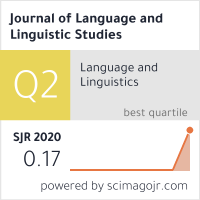Analyzing Interpersonal Metadiscourse Used In English Language Learning Videos On Youtube
Abstract
This research aims to analyze interpersonal metadiscourse in English language learning videos published on YouTube. The samples were 30 video scripts produced by native English speakers, including American, British, Canadian, and Australian. The framework was based on an interpersonal metadiscourse model by Hyland (2005) to describe their categories and functions. The data collection procedures employed an approach of Computer-Mediated Discourse Analysis (CMDA) suggested by Herring (2004). The steps included developing research questions, selecting data samples, defining framework concepts, applying analysis methods, and interpreting data. The results showed a greater number of interactional metadiscourse markers than interactive, indicating that the speaker prioritized engaging their audience with the video contents. Despite fewer occurrences, interactive metadiscourse markers played a crucial role in guiding the audience through the video content. The analysis results can provide a guideline for producing useful scripts for English language learning videos.
Keywords
Full Text:
PDFReferences
Ädel, A. (2006). Metadiscourse in L1 and L2 English (Studies in Corpus Linguistics). John Benjamins
Publishing Company.
Aguilar, M. (2009). Metadiscourse in Academic Speech: a relevance-theoretic approach.
Antonio, A., & Tuffley, D. (2015, January 16) YouTube a valuable educational tool, not just cat videos [Video]. The Conversation. https://theconversation.com/youtube-a-valuable-educational-tool-not-just-cat-videos-34863/
Azijah, D., & Gulo, I. (2020). Interpersonal metadiscourse markers in Jacinda Ardern speech at Christchurch memorial. Linguistics and Literature Journal, 1(2), 70-77. http://jim.teknokrat.ac.id/index.php/linguistics_and_literature/article/view/594/177
Bonnot, C. (2021, January 14). What are the different types of discourse?. Wisegeek. https://www.wisegeek.com/what-are-the-different-types-of-discourse.htm
Brame, C.J. (2016). Effective Educational Videos: Principles and Guidelines for Maximizing Student Learning from Video Content. CBE—Life Sciences Education, 15(4), 1-6. https://www.lifescied.org/doi/10.1187/cbe.16-03-0125
Cameron, A. (2019, June 28). Easiest way to download YouTube transcript/subtitles as plain text [Video]. Youtube. https://www.youtube.com/watch?v=vxb0X1fdbaI
COVID-19 Educational Disruption and Response. (2020, March 24). UNESCO. https://en.unesco.org/news/covid-19-educational-disruption-and-response
Herring, S. (2004). Content analysis for New Media: rethinking the paradigm. In New Research for New Media: Innovative Research Methodologies Symposium Working Papers and Readings (pp. 47-66). Minneapolis, MN: University of Minnesota of Journalism and Mass Communication. http://ella.slis.indiana.edu/~herring/newmedia.pdf
Hyland, K. and Tse, P. (2004). Metadiscourse in academic writing: a reappraisal. Applied Linguistics, 25(2), 156-177. https://doi.org/10.1093/applin/25.2.156
Hyland, K. (2005). Metadiscourse: Exploring interaction in writing. Continuum.
Hyland, K. (2017). Metadiscourse: what is it and where it is going?. Journal of Pragmatics. 113, 16-29. https://www.sciencedirect.com/science/article/abs/pii/S0378216616306245
Kuswoyo, H., & Siregar, R. A. (2019). Interpersonal metadiscourse markers as persuasive strategies in oral business presentation. Lingua Culture, 13(4), 297-304. http://doi.org/10.21512/lc.v13i4.5882
Lee, K. (2020, March 17). Coronavirus: 14 simple tips for better online teaching. The Conversation. https://theconversation.com/coronavirus-14-simple-tips-for-better-online-teaching-133573
Martin, J. & Rose, D. (2003). Working with discourse: meeting beyond the clause. Continuum.
Mayer, R. E. (2008). Applying the science of learning: Evidence-based principles for the design of multimedia instruction. American Psychologist, 63(8), 760–769. https://doi.org/10.1037/0003-066X.63.8.760
Mclean, R. (2013, December 25). What is a signpost in public speaking? 9 Examples. Slightly Unconventional. https://slightlyunconventional.com/what-is-a-signpost-in-public-speaking/
Rheisa, N. S. (2019). Metadiscourse as rhetorical strategy in YouTube review videos. Proceedings of the 3rd English Language and Literature International Conference (ELLiC), Indonesia, 3, 315-323. https://jurnal.unimus.ac.id/index.php/ ELLIC/article/view/4726
Sari, M. A. (2014). Interpersonal metadiscourse markers used in Michelle Obama’s speech [Thesis, Dian Nuswantoro, University]. http://eprints.dinus.ac.id/8303/1/jurnal_14016.pdf
AUTHOR BIODATA
Pristsana Koonnala works as a lecturer at the Department of Languages and Communication, Faculty of Business Administration and Liberal Arts, Rajamangala University of Technology Lanna (RMUTL). She currently serves as the Assistant to the Dean for International Relations and Head of the Language Center, RMUTL. Her research interests include English as a foreign language and discourse analysis.
Napasporn Chaiwong works as a lecturer at the Department of Languages and Communication, Faculty of Business Administration and Liberal Arts, Rajamangala University of Technology Lanna (RMUTL). Her interests are in discourse analysis, pragmatics and semantics.
Refbacks
- There are currently no refbacks.

This work is licensed under a Creative Commons Attribution-NonCommercial-NoDerivatives 4.0 International License.
ISSN 1305-578X (Online)
Copyright © 2005-2022 by Journal of Language and Linguistic Studies
